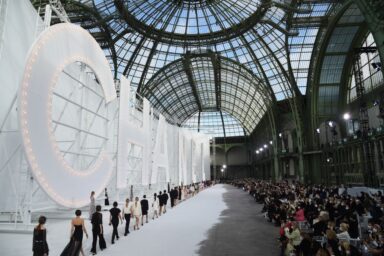Effortlessly bridging the gap between fashion, lifestyle and culture, Budapest has a lot on offer – and, equally, for the taking. Read away
With the world’s downturns taking over our lives, many of us have been turning heads to culture to maintain our social lives afloat. And as the new season creeps in our calendars, it’s time to dive into new offerings: whether you’re fond of fashion, wellness (look no further than the Gellert, Széchenyi and Rudas baths) or art, Budapest has something great for the taking. Special fashion-themed programmes enlivened the capital in the first week of September, for the tenth-year jubilee of Budapest Central European Fashion Week (hailed in the Museum of Fine Arts for the SS23 edition). A plethora of shows and contemporary exhibitors filled the world heritage location, allowing national and international designers to present their collections to industry insiders and the public. Budapest is a goldmine for Hungary’s hidden treasures: as part of the city’s ever brilliant underpinnings, the Four Seasons Gresham Palace—a treasure-trove of architectural excellence oozing Art Nouveau glory and nestled within the very heart of the city on the banks of the Danube—is a five-star stunner that is romantically steeped with retro masterpieces, coated with soothing tones and regal, towing furnishings. Further facilities include a warm, compelling spa with seven treatment rooms offering a gamut of beauty rituals, with the likes of a scented Finnish sauna, a fully equipped gym among others. Of particular note is the infinity edge rooftop pool with panoramic views over the city and an adjacent whirlpool. In short, an utter delight for the senses.
And breathe.
Having missed the magic of IRL catwalk offerings since Covid-19 shook up the world, the HFDA (Hungarian Fashion and Design Agency) offered us a way to fill that incredibly large, fashion-sized void in our hearts, whilst endeavouring to show the capital the brilliance of Ukrainian designers. “The Agency’s accentuated goal is to connect the Hungarian fashion and design industry to the global professional scene and, in the long run, turn Budapest into a regional centre, strengthening the country’s image,” explained added Zsófia Jakab, CEO of the HFDA.
If you’ve never heard of Kata Haratym, the eponymous sui generis fashion line, I’d highly recommend finding time in your Fashion Week schedule for a visit in Budapest (travel permitting, of course), which is currently hailing her new work. Which all of this preamble is to say that Haratym has powered an unwavering storytelling beneath those seams. The red string and thread symbolism epitomises many different cultures around the world, and its connotation varies depending on the region. For instance, in the Jewish Kabbalah, the red thread on one’s wrist protects the wearer from evil eye, while in Japan there’s a legend about populations being tied with their soulmate via a red string on their pinky finger. In Nordic and European countries, the expression red thread refers to the core idea or theme of something, and Kata Haratym’s Spring/Summer 2023 collection took inspiration from this phenomenon by way of natural fibres like embroidered linen with macrame accessories to match, suffusing the presence of crocheted details too. Silhouettes are as always very gentle and breezy, owning a detailed structure (like the breast plates) that bring historical bits of architecture to mind.
Calling on the figures brought to life during the rituals (in Moha, a village in Hungary, where streets are lined with barely more than a hundred houses), ZSIGMOND’s Spring/Summer 2023 collection is an homage to village traditions that bind people together, strangers as much as friends. These observations led to a utility-driven, dystopian wardrobe, with highly technical, whip-corded outerwear (in a palette of neutrals and brights, similar to this season’s excellent catwalk offerings), shaggy pants and funkily OTT accessories. So here comes the question: is self-preservation trending amid high-street and luxe-driven designers? It would make sense, given the times. Amid the proclivity for utilitarianism, there’s still room for fun: characters revived in the inspirations are depicted within the prints of the collection designed by tattooist and artist Áron Dimén. Each design is firstly etched in lino, before screen-printed onto the garments, giving them a coarseness, or better, “a texture-beyond-texture.” The limited REMADE line made from upcycled hundred-year-old fabrics is extended with new styles, such as jumpers, vests, shirts and shorts. The zero-waste REMADE hats are hand- made in collaboration with Vecsei Millinery in Hungary. The best looks had a slouchier feel. In one refreshing pairing, a peachy orange sweatshirt topped a loose pair of pitch black drawstring shorts. Styled with high socks, it got the gist of cosy-like coolness. This was a slyly playful take on practical wear, strong on textural objectification that will surely stimulate any hype spirit. Call it technical, call it sports, but the symbolism of tailoring from Budapest designers confers ample evidence that a functional dialect has imbued the core lingua franca of Hungarian menswear. ZSIGMOND is a promising label that speaks this language with great depth.
“Shapes! Neutralism! Proportions!” enthused GUDU’s Lasha Mdinaradze after sending a dozen black-tinged offerings down the runway. With this collection he proved that minimalism is all the rage—though the designer used lots of it to embody a new kind of woman, highlighting how global shifts keep shaking up the fashion world and inviting us to “get back to basics and to the foundations on which everything is built.” In a season where designers are ditching creative impulses for practical (mm-hmm, sellable) numbers for shoppers, Mdinaradze accented his looks through a variety of crop tops and dresses with bold cutouts, midi-length skirts, and flowing trousers. With his taste slightly dusky and skin-tight toppers, he could hardly script it better. “Customers come back to us for jackets from season to season, [and] they allow me to experiment with shape and proportions ,but at the same time adorn the female body and emphasise the strength of character,” reckons the designer. “In fact, the collection is my vision of what and how you can combine our jackets. I wanted to offer an understandable constructor made of high-quality, comfortable, but not faceless clothes.” That was certainly on display: Mdinaradze pronounced this collection both darker and sleeker than previous outings. It was both of those things—and bolder for them. Quirkiness waned, neutrality was kept intact. In a world of precariousness and crisis announced at every news blast, his latest offering seemed logical. (The slouchy, billowy garb made frequent appearances, enhancing the collection with volumes he’s known for). Overall, there wasn’t something for everyone. But Mdinaradze’s woman will find plenty to cheer on.
Give the customer what she wants—that’s Darja Donezz’s mantra for her contemporary yet Classically-tinged Spring Summer 2023 collection, claiming antique legends and prominent female figures in ancient Greek mythology as inspirations. That means the line up touches on familiar trends like blazers, fluid dressing, peplums, and sculpted prints—all well executed. This may not be the passion project that the brand is, but this focused designer clearly did her homework. The new Spring collection is full of Donezz-isms both high and low, comprising femining riffs on tailored offerings. Embroidered prints came with effortless appeal: Black, shades of sand and dusty blue. The grecian attitude came across via sharply cut pieces, including a pastel blue set with finely-sewn trims, as well as a blazer cut jacket with a slightly psychedelic, maxi surface pattern. “A couple years ago, I saw a dress with fishes before my eyes, and from then [this motif] features in every collection,” opined Donezz. We’d have to concur: These wearable clothes didn’t require much explanation to grasp their novel appeal.


